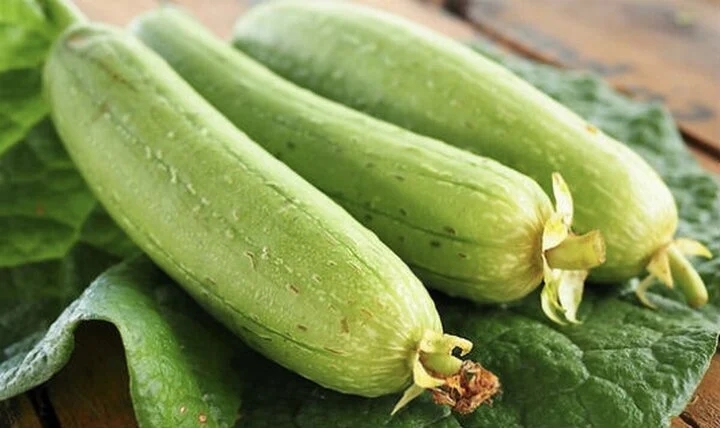Mướp is a versatile vegetable that can be cooked in a variety of ways, including soups, stir-fries, and boiling. It is a delicious and nutritious addition to any meal. However, not everyone knows how to choose the best mướp. Should you pick one with veins or without? This is a common question among consumers.
What type of mướp should you buy? Veined or veinless?
Mướp with prominent veins running along its surface tends to have a rougher texture and feels firmer to the touch. These veins are a sign that the mướp is fully mature.
Veined mướp is typically firmer and heavier, packed with nutrients, water, and flesh. It tends to have a more robust flavor, making it ideal for soups and stir-fries.
On the other hand, veinless mướp has a smoother surface with less prominent veins. It usually has a thinner skin and feels lighter in weight.
The skin of veinless mướp is often softer and requires less peeling during preparation. Its flavor is milder, making it suitable for lighter dishes. Veinless mướp generally contains less water and flesh.
So, which one should you choose? Veined or veinless mướp? It depends on your personal preference and intended use. If you’re looking for a bolder flavor and more nutrients, go for veined mướp. Choose one with dark green skin, a firm texture, and prominent veins. If you prefer a quicker preparation or lighter dishes, opt for veinless mướp. Look for light green skin, a smooth surface, and a lighter feel.

Veined or veinless mướp: Which one to choose? (Photo: Happynest)
The Health Benefits of Mướp
Mướp is a nutritional powerhouse, offering a range of health benefits thanks to its rich vitamin and mineral content:
Heart Health: Mướp is rich in vitamin B5, which helps lower bad cholesterol levels and triglycerides, reducing the risk of cardiovascular disease.
Diabetes Prevention: Manganese, abundant in mướp, plays a crucial role in producing digestive enzymes and regulating blood sugar. It also promotes insulin production. Studies in mice have shown improved glucose tolerance in those supplemented with manganese.
Weight Loss Aid: With minimal saturated fat and low-calorie content, mướp is an excellent choice for those watching their weight. Its high water content also aids in satiety and hydration.
Digestive Health: Mướp is packed with fiber, antioxidants, and vitamins, making it a digestive powerhouse. The soluble fiber in mướp softens stools, promotes regular bowel movements, and prevents constipation, maintaining a healthy digestive system.
Additionally, mướp contains digestive enzymes and supportive compounds that enhance nutrient absorption. Its anti-inflammatory and antimicrobial properties protect the digestive tract lining from harmful bacteria.
Muscle Pain Relief: The anti-inflammatory and antioxidant properties of mướp can help reduce inflammation and soreness, especially after workouts or muscle tension. Rich in minerals like potassium, magnesium, and vitamin K, mướp supports muscle health and function.
Arthritis Relief: Copper, present in mướp, exhibits anti-inflammatory properties that soothe stiffness and pain associated with arthritis. It strengthens muscles, repairs connective tissues, and supports joint health. This is why some people with arthritis wear copper bracelets, believing it alleviates joint symptoms.
Anemia Treatment: Anemia is a condition where the body lacks sufficient iron to produce hemoglobin, an essential component of red blood cells. Vitamin B6 is critical in hemoglobin synthesis, and mướp is a good source of this vitamin. Regular consumption of mướp can help improve anemia symptoms and prevent its occurrence.
Diuretic Properties: Mướp acts as a natural diuretic, aiding the body in flushing out toxins and reducing arterial blockages. Its high water and antioxidant content support detoxification and the elimination of waste through urine.
Sinusitis Relief: Sinusitis is an inflammatory condition of the nasal passages. The anti-inflammatory compounds in mướp can help alleviate this condition. Additionally, mướp’s antioxidants boost the immune system and reduce the impact of allergies, a common trigger of sinusitis.
Storing Mướp:
Proper storage of mướp ensures it stays fresh and retains its nutritional value. Here are some effective tips for storing mướp:
– Room Temperature Storage: Mướp can be kept at room temperature for a few days. Store it in a cool, dry place, away from direct sunlight.
– Refrigeration: For extended storage, place mướp in the vegetable drawer of your refrigerator. Keep it in a plastic bag or wrap it in plastic wrap to maintain moisture.
– Avoid Moisture: When storing mướp, avoid exposing it to moisture or a damp environment, as this can cause spoilage.
Source: VTC news


































